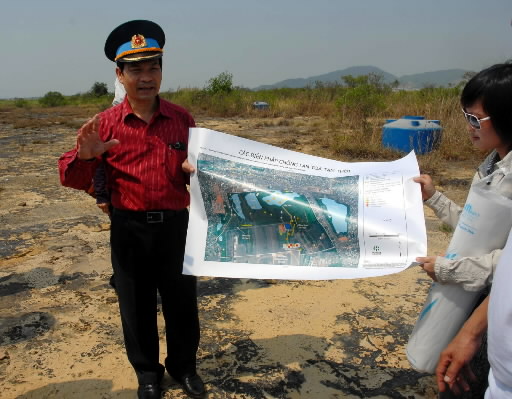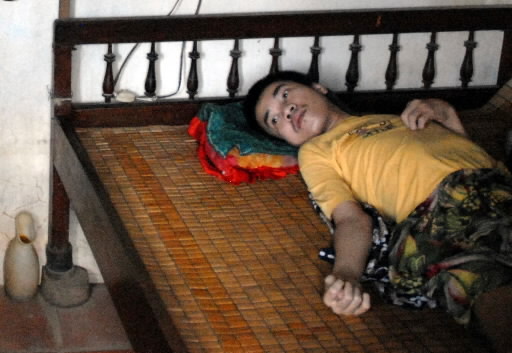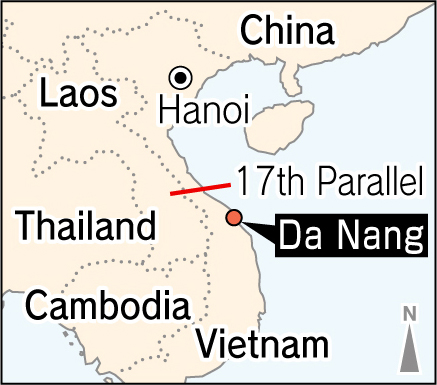Vietnam: 50 years after the use of defoliants, Part 1: Walking the affected areas, Article 1
Jul. 6, 2012
Article 1: Hot spots
People and land suffer lingering effects
by Takamasa Kyoren, Staff Writer
Pungent smell near international airport
Fifty years have passed since the U.S. military began using defoliants in 1961 during the Vietnam War. Traces of the defoliants, which contained highly poisonous dioxin, remain in people’s bodies and in the environment. Efforts to shed light on the extent of their effects and to provide compensation are lagging. Finally, this year a full-scale decontamination project will be launched. As memories fade, just as with Hiroshima and Nagasaki, how do the victims feel? I walked through contaminated areas.
A turquoise passenger plane disappeared into the blue sky with a roar as it took off from Da Nang International Airport in central Vietnam. The soil in an extensive area of the airport grounds north of the runways is mottled with black and yellow. A pungent odor assaulted my nose. This is one of 28 so-called “hot spots” in Vietnam, which are heavily contaminated with dioxin from defoliants.
400 times safe level
In some places the level of dioxin in the soil in the vicinity of the airport is 400 times the international standard deemed safe to live with. A full-scale joint Vietnam-U.S. effort to remove the dioxin in the soil by treating it with high heat will get underway this summer.
“Even now, 37 years after the end of the war, no vegetation will grow here,” said Tran Ngoc Tam, 59, as he pointed to a map. Mr. Tran, deputy director of the Scientific Department of the Vietnam Association for Victims of Agent Orange/Dioxin (VAVA), is involved in the government effort to clean up hot spots. The water flowing in the canal that wended its way along at his feet was black. “Toxins can get into the body by being breathed in or absorbed through the skin,” he said. “We’ll only be here for a short time today, so we don’t need to wear protective clothing.”
Da Nang, the largest city in central Vietnam, is home to approximately 900,000 people. The 17th parallel, which served as the dividing line between North and South Vietnam, is 150 km north of the city.
During the war, Da Nang Airport was the largest U.S. Air Force base in South Vietnam. It also served as a base for U.S. military aircraft that sprayed defoliants, and from 1964 to 1971 about 14 million liters of defoliant were stored and loaded onto aircraft at the airport. Defoliant sometimes spilled while being loaded or leaked from drums that were damaged. After spraying defoliant, the aircraft were washed down, and contaminated water ran onto the ground.
“Local residents didn’t know”
The half-life of the dioxin in the soil is said to be 10 years by some, 25 years by others. It accumulates in the body after being breathed in, absorbed through the skin or consumed in food. Some have pointed out the carcinogenicity of dioxin and its harmful effects on reproductive organs. Until 1990, when an environmental study was launched by the Vietnamese government and others, the extent of the contamination was covered up.
“Compared to other areas, the vicinity of Da Nang International Airport has a higher incidence of babies born with abnormalities and more cancer patients,” said Mr. Tran. Water from a canal leading away from the airport flows into a pond between the airport and a residential area. According to a study by the government and others, dioxin was detected in the mud at the bottom of the pond at about 10 times the international standard. After that, a facility to remove the dioxin from the water before it flowed into the pond was built.
I visited the offices of the Da Nang Association for Victims of Agent Orange/Dioxin. “The people of Hiroshima and Nagasaki have provided us with support,” said Nguyen Thi Hien, president of the organization. Its facilities include rooms for rehabilitation and occupational training. When asked about the problem of the airport, he said, “Residents had no idea toxins would flow from the area,” he said. “They drank water from the pond and used it to water their paddy fields.”
Approximately 5,000 residents of Da Nang are victims of defoliants. I was taken to the home of Tran Duc Nghia, 37, and his sister, Tran Thi Tien Nga, 35. Both of them were born with brain damage, and their arms and legs are paralyzed. Their father died seven years ago. Their mother, Hoan Thi Te, 74, takes care of them.
Nghia lay on a bed in a dimly lit room. “Who will take care of him when I am gone?” said his mother in a tremulous voice as she stood at his bedside. The effects of defoliants linger throughout Vietnam.
(Originally published on June 19, 2012)










